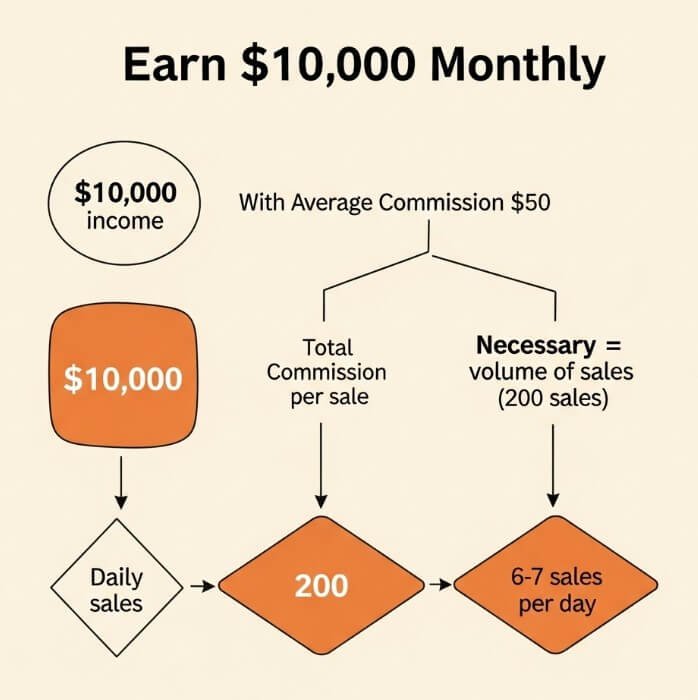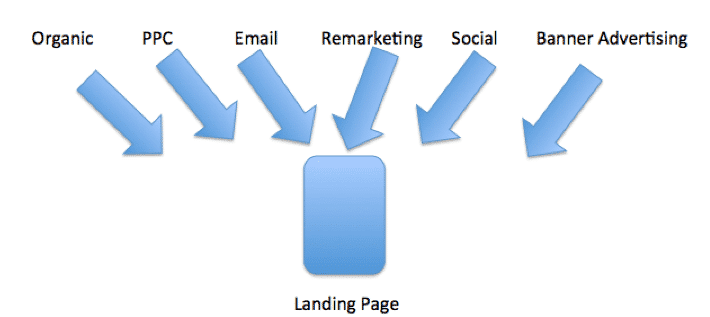Think of affiliate marketing like opening a small business. While some entrepreneurs do build million-dollar companies, most start with much smaller ambitions and grow gradually. Understanding this comparison helps set realistic expectations for what affiliate marketing actually requires and what you can genuinely expect to achieve.
Understanding the Affiliate Marketing Landscape
Affiliate marketing operates on a simple premise: you promote someone else's product or service and earn a commission when people make purchases through your unique referral link. However, the mechanics beneath this simple concept reveal a complex ecosystem that rewards specific skills and strategies.

Consider how traditional salespeople work. The most successful ones don't just pitch products randomly to everyone they meet. Instead, they build relationships, understand their customers' needs, and present solutions at the right moment. Affiliate marketing follows similar principles, except your "sales floor" is the entire internet, and your potential customer base spans globally.
The commission structures vary dramatically across industries. While some programs offer modest 3-5% commissions on physical products, others provide 30-50% or even higher percentages for digital courses, software subscriptions, or high-ticket services. This variance creates different pathways to reaching that $10,000 monthly goal.
Related: Double Your Income With These 62 High Paying Affiliate Programs
Breaking Down the $10,000 Monthly Goal
Let's examine what earning $10,000 monthly actually means in practical terms. If you're promoting products with an average commission of $50 per sale, you'd need to generate 200 sales each month. That breaks down to roughly 6-7 sales per day, which might seem manageable until you consider conversion rates.

Most affiliate marketing campaigns convert between 1-3% of visitors into buyers. Using a conservative 2% conversion rate, you'd need approximately 10,000 website visitors monthly to generate those 200 sales. This calculation helps illustrate why successful affiliate marketers focus heavily on traffic generation and audience building.
However, these numbers shift dramatically with different products and strategies. Pat Flynn, founder of Smart Passive Income, generates substantial affiliate revenue by promoting high-value courses and software tools to his engaged email list of entrepreneurs. His approach demonstrates how targeting the right audience with premium products can reduce the volume of sales needed while increasing the commission per transaction.
The key insight here is that reaching $10,000 monthly isn't about finding a magic formula but rather about building systems that consistently deliver value to your audience while strategically promoting relevant products.
The Reality of Timeline and Expectations

One of the biggest misconceptions about affiliate marketing involves timing. Many newcomers expect rapid results, but successful affiliate marketers typically describe their journey in years, not months. Building the foundation for substantial affiliate income requires developing multiple interconnected skills.
Consider Michelle, who started a personal finance blog while working her full-time job. Her first year generated less than $500 in affiliate commissions. However, she consistently published helpful content, built an email list, and learned about her audience's financial challenges.
By year three, her monthly affiliate income exceeded $8,000, primarily from promoting budgeting tools, investment platforms, and financial courses that genuinely helped her readers.
This timeline reflects a common pattern. Most successful affiliate marketers spend their first 6-12 months learning the fundamentals: creating content, understanding their audience, and building basic marketing systems. The second year typically involves refining these systems and seeing modest but growing income. Substantial earnings often emerge in years two through four as compound effects take hold.
Essential Skills for Affiliate Marketing Success

Succeeding in affiliate marketing requires developing several interconnected capabilities. Content creation forms the foundation because your ability to communicate value determines everything else. Whether you're writing blog posts, creating videos, or posting on social media, your content must genuinely help people solve problems or achieve goals.
Marketing psychology becomes equally important. Understanding why people make purchasing decisions helps you present affiliate products in ways that feel helpful rather than pushy. The most successful affiliate marketers act more like trusted advisors than traditional salespeople.
Technical skills also play a crucial role, though you don't need to become a programmer. Learning basic website management, email marketing systems, and analytics tools helps you build and optimize your marketing systems independently.
Perhaps most importantly, successful affiliate marketers develop strong research abilities. They become experts at identifying their audience's pain points, finding products that genuinely address those problems, and presenting solutions authentically.
Choosing Your Niche and Products Strategically

Your niche selection significantly impacts your earning potential. Some niches naturally support higher commission products, while others rely on volume sales with smaller margins. The personal finance niche, for example, includes high-value products like investment courses, financial planning software, and premium credit cards with substantial sign-up bonuses.
John Chow built a successful affiliate marketing business in the "make money online" niche by sharing his own experiences and promoting tools he actually used. His authenticity in discussing both successes and failures helped build trust with his audience, making his product recommendations more effective.
Technology niches often provide opportunities for recurring commissions through software affiliate programs. When someone signs up for a monthly software subscription through your link, you might earn commissions for as long as they remain a customer. This recurring revenue model can be particularly powerful for reaching consistent monthly income goals.
However, passionate hobbyist niches shouldn't be overlooked. A dedicated gardening enthusiast who builds a strong following might successfully promote gardening tools, courses, and supplies to an engaged audience that trusts their expertise.
Building Traffic and Audience

Traffic generation remains one of the most challenging aspects of affiliate marketing, but understanding the different approaches helps you choose strategies that match your strengths and resources. Search engine optimization represents a long-term strategy that can provide consistent, free traffic once your content ranks well for relevant keywords.
Social media marketing offers faster feedback loops and more immediate audience interaction. Platforms like YouTube, Instagram, and TikTok allow creators to build personal brands while promoting affiliate products naturally within their content.
Paid advertising can accelerate results but requires careful management to remain profitable. Many successful affiliate marketers start with free traffic methods, then reinvest their early earnings into paid advertising to scale their efforts.
Email marketing often provides the highest conversion rates for affiliate promotions because subscribers have already expressed interest in your content. Building an email list from the beginning, even if it grows slowly, creates a valuable asset for promoting affiliate products to engaged prospects.
Avoiding Common Pitfalls

Many aspiring affiliate marketers make predictable mistakes that slow their progress significantly. Promoting too many different products without building expertise in any particular area creates confusion for both you and your audience. Instead of becoming a trusted expert in solving specific problems, you risk appearing like someone who promotes anything for a commission.
Neglecting to disclose affiliate relationships properly can damage trust and potentially create legal issues. Transparency about affiliate partnerships actually builds credibility with most audiences when handled professionally.
Focusing solely on high-commission products without considering your audience's actual needs often backfires. Your audience notices when recommendations feel forced or irrelevant, which damages the trust necessary for long-term success.
Perhaps most importantly, many people quit too early. Affiliate marketing success typically requires consistent effort over extended periods. Those who expect overnight results often abandon their efforts just as their systems begin generating momentum.
Real Success Stories and Lessons
Ryan Kaji's family built a YouTube empire around toy reviews that generates millions in affiliate revenue, but their success required years of consistent content creation and audience building. While their scale is exceptional, their approach demonstrates core principles that apply at smaller scales too.

Wirecutter, before being acquired by The New York Times, became a massive affiliate marketing success by providing genuinely helpful product research and recommendations. Their approach of thoroughly testing products and providing detailed comparisons created immense value for readers while generating substantial affiliate revenue.
These examples share common elements: they focus intensely on serving their audience's needs, maintain high content quality standards, and build trust through consistent value delivery over time.
Building Your Path to $10,000 Monthly

Creating a realistic plan for reaching $10,000 monthly in affiliate income starts with understanding your current position and available resources. If you're starting from zero, focus first on choosing a niche where you have genuine interest and some existing knowledge.
Develop a content calendar that allows for consistent publishing while maintaining quality standards. Whether you choose blogging, video creation, or social media content, consistency matters more than perfection, especially in the beginning.
Start building your email list immediately, even if you only add a few subscribers each week. These subscribers represent your most valuable audience for affiliate promotions because they've actively chosen to hear from you.
Track your metrics carefully from the beginning. Understanding which content generates traffic, which products your audience responds to, and what marketing methods work best for your situation helps you optimize your efforts over time.
Choosing Your Platform: Where to Build Your Affiliate Marketing Empire
The platform you choose to build your affiliate marketing business fundamentally shapes your approach, audience interaction, and income potential. Each channel offers distinct advantages and challenges, and understanding these differences helps you select the right foundation for your specific goals and strengths.
Traditional Blogging
One of the most effective long-term affiliate marketing strategies is still traditional blogging via your own website. You have complete control over the user experience when you own your website, including how affiliate links are integrated and how the content is presented. As you grow, this control becomes even more valuable because you won't be affected by platform policy changes or algorithm changes that could suddenly have a significant impact on your reach.
Affiliate marketers have a great deal of flexibility with WordPress blogs. You can make thorough product comparison posts, optimize each page for search engines, and compile extensive resource libraries that draw visitors for years. The main benefit is the potential for search engine optimization—well-written blog posts can appear on Google's first page for important keywords, generating steady, free traffic from users.
However, building website traffic from zero requires patience and consistent content creation. Most successful affiliate bloggers publish multiple high-quality posts weekly for at least 12-18 months before seeing substantial traffic growth. The compound effect of this consistent publishing eventually creates powerful momentum, but the initial period can feel slow and discouraging.
YouTube
YouTube presents a different opportunity entirely. Video content allows you to demonstrate products, share personal experiences, and build deeper connections with your audience. The platform's massive reach means that even relatively small channels can generate significant affiliate income when they target the right keywords and create genuinely helpful content.
Product review videos, tutorial content, and comparison videos perform particularly well for affiliate marketing on YouTube. When viewers can see you actually using a product and explaining its benefits or drawbacks, they develop stronger trust in your recommendations. This trust translates directly into higher conversion rates compared to text-based content alone.
The challenge with YouTube lies in the time investment required for video production and the platform's competitive nature. Creating quality videos requires learning editing skills, understanding lighting and audio, and developing on-camera presence. Additionally, YouTube's algorithm heavily favors consistent uploaders, meaning successful channels typically require multiple videos per week to maintain growth momentum.
SM Like TikTok
Social media platforms like Instagram, TikTok, and Facebook offer more immediate audience interaction and faster feedback loops on your content. These platforms excel at building personal brands and creating viral moments that can rapidly expand your reach. Short-form content on TikTok and Instagram Reels can introduce your affiliate products to thousands of potential customers within days rather than months.
TikTok's algorithm particularly favors engaging content over follower count, meaning new creators can achieve substantial reach quickly if their content resonates with viewers. This democratization of reach creates opportunities for rapid affiliate marketing growth that weren't possible on older platforms. However, the platform's young demographic and short attention spans require adapting your affiliate marketing approach to focus on products and presentation styles that work within these constraints.
Instagram works exceptionally well for lifestyle-focused affiliate marketing. Fashion, fitness, home decor, and beauty products naturally fit into Instagram's visual format. Successful Instagram affiliate marketers often build their presence around showcasing how products integrate into aspirational lifestyles, making their recommendations feel inspirational rather than overtly promotional.
Medium
Medium offers an interesting middle ground between traditional blogging and social media. The platform provides built-in distribution through its algorithm and community features while allowing for longer-form content that works well for detailed product reviews and educational content. Medium's Partner Program can provide additional revenue streams beyond affiliate commissions, though the platform's policies around affiliate links require careful attention.
Email marketing

Email marketing, while not a standalone platform, serves as the crucial connecting tissue between all these channels. Regardless of where you build your primary audience, converting followers into email subscribers creates a direct communication channel that you fully control. Email consistently provides the highest conversion rates for affiliate promotions because subscribers have explicitly opted to receive your content recommendations.
The most successful affiliate marketers often operate across multiple platforms simultaneously, using each channel's strengths strategically. They might use TikTok or Instagram to create awareness and attract new audiences, YouTube for detailed product demonstrations and reviews, and their email list for direct promotional campaigns. This multi-platform approach requires more work but creates multiple traffic sources and reduces dependence on any single platform's algorithm or policy changes.
Platform selection should align with your natural strengths and available time. If you enjoy writing and have patience for long-term growth, starting with a blog makes sense. If you're comfortable on camera and can commit to regular video production, YouTube offers tremendous potential. If you prefer quick, engaging content and want faster feedback, social media platforms might better match your style.
The Bottom Line
Making $10,000 monthly through affiliate marketing is absolutely achievable, but it typically requires treating it like building a real business rather than pursuing a get-rich-quick scheme. Success comes through developing valuable skills, consistently serving your audience's needs, and building systems that generate sustainable income over time.
The timeline to reach this goal varies significantly based on your niche, available time, existing skills, and marketing approach. Some people achieve it within 18-24 months of focused effort, while others may take 3-4 years to build the necessary foundation.
Rather than asking whether $10,000 monthly is possible, consider whether you're prepared to develop the skills, put in the consistent effort, and serve your audience's needs authentically over the time required to build a successful affiliate marketing business. For those willing to approach it professionally and persistently, the goal becomes not just possible, but probable.
